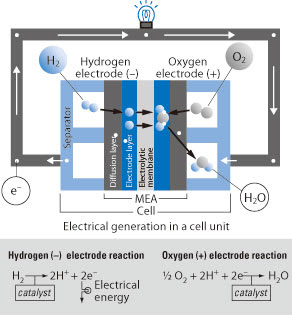SOLAR POWER
“In 1955, William G. Cobb of the General Motors Corp. (GM) demonstrates his 15-inch-long "Sunmobile," the world's first solar-powered automobile, at the General Motors Powerama auto show held in Chicago, Illinois.
Cobb's Sunmobile introduced, however briefly, the field of photovoltaics--the process by which the sun's rays are converted into electricity when exposed to certain surfaces--into the gasoline-drenched automotive industry.” [unknown, http://www.history.com/this-day-in-history/william-cobb-demonstrates-first-solar-powered-car. accessed 17 August 2010]
HYBRIDS
 |
| Toyota Prius |
With rising petrol prices and climate conscious consumers ever increasing, car manufacturers have realised a market exists to make alternative power sources for their cars. Forget early home-made solar panels with wheels, some of these cars are powered with state of the art technologies using Hydrogen combustion. The same type of combustion used in an Atomic bomb or H-bomb. For example, a technology developed by Toyota has been implemented in a number of cars. The most well-known being the Toyota Prius. This car is actually a Hybrid. Hybrid motor vehicles consist of two technologies combined to create a vehicle that emits less greenhouse gases. The Prius specifically combines a petroleum engine and an electric motor. The Prius has become the first mass produced hybrid vehicle and sales have reached record levels, with more than 100000 vehicles sold in 2009. [Erin Riches. 2010 Toyota Prius Sales Will Hit 100,000 in 2009, Toyota Says. http://blogs.insideline.com/straightline/2009/03/2010-toyota-prius-sales-will-hit-100000-in-2009-toyota-says.html. 17-august-2010]
 |
| Battery pack of the Toyota Prius |
HYDROGEN FUEL CELL
Another technology developed by GM in 1966 [Hydrogen Fuel cars now. http://www.hydrogencarsnow.com/gm-electrovan.htm. 17-august-2010] was the hydrogen fuel-cell powered motor vehicle. The Electrovan as it was called was the earliest use of Hydrogen to power a motor vehicle and was quite primitive. The reason Hydrogen fuel cells are actually the cleanest form of fuel is based on the fact its by-product or emission is actually pure water. No harmful greenhouse gases are produced when using a Hydrogen fuel cell. The top speed of the Electrovan was around 103 km/h and had a range of 193 kilometres. Eventually the costs of producing these vehicles outweighed their economic viability. A significant amount of Platinum metal was used to produce the fuel cell making the Electrovan exorbitantly expensive. The project was scrapped later due safety issues and the significant weight of the fuel cell which topped 250 kilograms.
 |
| General Motors Electrovan |
 |
| GM's fuel cell operation diagram |
Honda Motor Group has taken the Hydrogen fuel cell technology seriously and made some impressive technological developments over the past two decades. Honda began road testing fuel-cell vehicles in 1999 and in 2007 revealed its FCX Clarity vehicle. According to its website, Honda has began operation of a next generation solar hydrogen station that is meant to create the hydrogen fuel cell power needed to commute a car for one day. This can be done overnight. It is considered a home plug in unit and definitely is a step in the right direction. Making these technologies more accessible and less hippy will definitely make the technology more mainstream and appeal to a wider audiences.
For more information on the Fuel Cell technology and how it works visit http://world.honda.com/FuelCell/FCX/fuelcell/structure/
BIOFUELS
Biofuels has become quite popular in recent years, mostly due to the fact that it is cheaper than regular petroleum and gas. Biofuel is derived from biomass or bio-waste and the top five crops used to produce it are: Maize, Canola, Sugar Cane, Palm oil and Jatropha. [The Top Five Biofuel Crops. http://knowledge.allianz.com/en/globalissues/energy_co2/renewable_energy/biofuels_crops.html. 17-aug-2010]. When these crops are processed, ethanol or alcohol is produced. This is mixed with regular diesel or petrol to produce biofuel. Biofuel is used in heavy industries such as long-haul transport, shipping and agriculture mostly. The fact that crops are cheaper to produce than extracting petroleum from oil makes this an attractive alternative to fossil fuels. In some countries, people are moving away from harvesting crops for agriculture and rather growing crops that are used for biofuel. The sad reality is that because farmers are moving away from traditional crops that will feed people, there will be a drop in the amount of food produced. In poorer countries like Mali and Gambia, where many people rely on staples such as corn and rice, there is now less crops being produced to feed the poor. So there are upsides and downsides to biofuel and governments around the world vary in their point of view on this issue.
 |
| http://keetsa.com/blog/wp-content/uploads/2007/08/co2cycle.jpg |
For more information on biofuels, visit this site... http://news.bbc.co.uk/2/hi/science/nature/6294133.stm
 |
| http://www.bigpictureblog.info/wp-content/uploads/2009/04/biofuels-cartoon.gif |
What I think the author of this article is missing though is fact that these cars are designed to save the environment, not around saving you money. In the not too distant future, petrol will run out and we will be forced to use alternative sustainable fuel sources for our transportation, and this technology is setting a precedent for the inevitable.




No comments:
Post a Comment